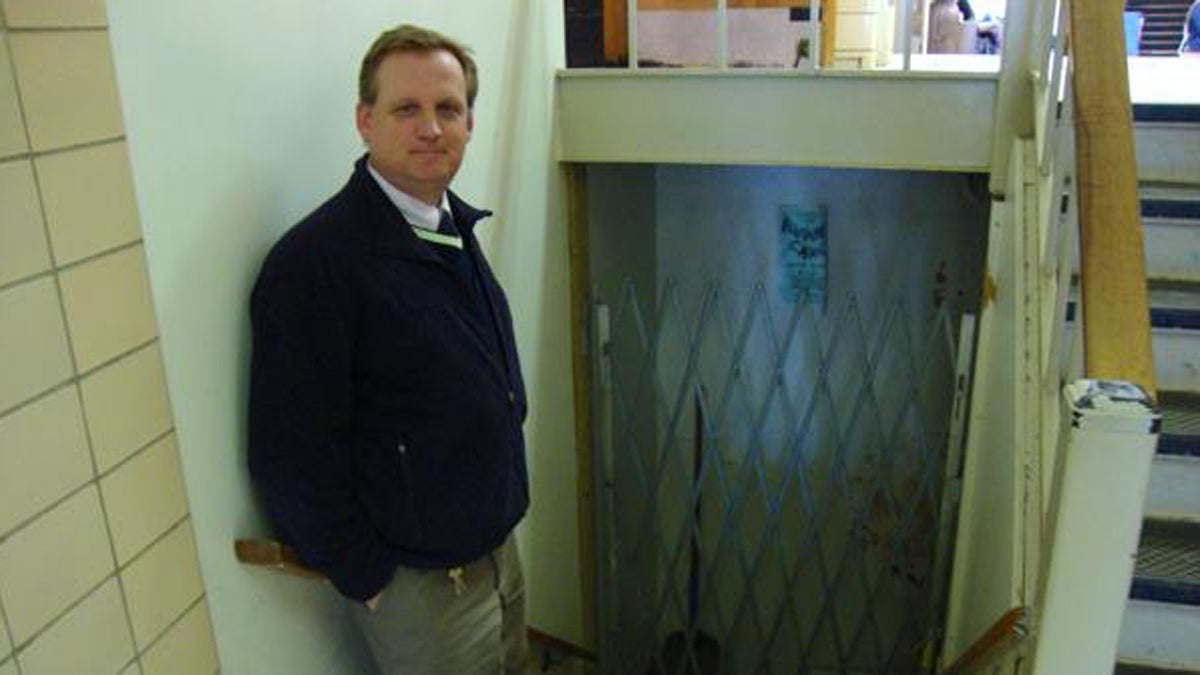Voters to decide on $85 million referendum for State High renovations and additions
Listen
State High dean of students, Chris Weakland, stands next to the entrance to storage space under the auditorium stage. It's gated because of flooding and mold.(Emily Reddy for WPSU)
Tuesday’s election will have more than just primary candidates on the ballot. Voters in the State College school district will decide whether to approve an 85 million dollar referendum to pay for renovations and additions to State College Area High School. Only one school district in Pennsylvania has managed to pass a referendum like this one since Act 1 passed in 2006, capping yearly school tax increases.
This story was first published by partner station WPSU, Penn State Public Media.
Tuesday’s election will have more than just primary candidates on the ballot. Voters in the State College school district will decide whether to approve an 85 million dollar referendum to pay for renovations and additions to State College Area High School. Only one school district in Pennsylvania has managed to pass a referendum like this one since Act 1 passed in 2006, capping yearly school tax increases.
A group of teachers at the high school, including English teachers Allison Becker and Jennifer Rand, are pushing for a “yes” vote.
The furnace in Rand’s classroom was broken on all winter, keeping it at 85 or 90 degrees all the time.
“It’s just not a situation where it’s conducive for learning,” said Rand. “I actually had students writing essays in here today and two kids fell asleep writing essays. I mean this is cozy to say the least.”
The heating system is so old that they no longer make parts for it. The maintenance staff patch and repair as they can, but school officials say the HVAC needs to be replaced. Meanwhile, Rand’s room is probably 85 or 90 degrees.
In addition to her HVAC woes, there are cracks and asbestos tiles on the walls. In other classrooms, ice forms on the insides of windows in the winter. A ceiling light recently caught on fire. One classroom has flooded twice, thanks to a broken boiler. The auditorium once flooded up to row K.
And then there’s the basic setup of the high school. It’s divided into two separate buildings on different sides of a busy street. Many teachers and students cross Westerly Parkway multiple times a day in the scant 6 minutes between classes.
“I taught in both buildings for 3 years,” said Becker. “It was tricky, especially in the winter. I did it one year when I was pregnant too.”
In Becker’s classroom, she shows off where a student’s project froze to the window this winter. And she points out where a big chunk of linoleum has broken off the floor.
“The students in first period tried to taped the tile back on,” said Becker. “They told me on Friday that ants were crawling out of the floor and actually crawled onto a student while he was trying to read The Crucible, and he ran out screaming.”
Dean of Students Christopher Weakland says beyond physical breakdown, the buildings aren’t set up for modern educational models of collaborative learning communities.
And in an age of school shootings, it’s not very secure. There are 93 doors that are all left unlocked so students can come and go between buildings. Weakland says the community has an obligation to fix these things.
“My children have gone through. I’m done,” said Weakland. “But I know, I realize, I need to provide for the kids who come afterwards. And if we have the attitude of we’re going to ignore those kids, they’re not my problem, we’re living in a pretty sad community. And that’s not who we are. That’s not what State College is all about.”
Teachers, parents and school board members have been holding informational sessions and going door-to-door, asking community members to vote for the referendum. They’ve been writing Letters to the Editor and sharing photos and videos of current conditions. They have a website with drawings of what the renovated and new, consolidated high school building will look like when it’s done.
The plan is that just under 40% of the building will be renovated and 60% will be new construction. The reuse should save 15 to 20 million dollars in the overall cost of the project.
Despite the economies, school board chair Jim Pawelczyk acknowledges it’s still a lot of money. He originally voted against the referendum because he was worried about the $85 million number, but he and the rest of the school board are all behind it now. Pawelczyk says this project needs to be done.
“It was just the number. The referendum is absolutely needed, said Pawelczyk. “It’s a great project that I support. And it’s just that the number concerned me. And it still continues to worry me. And that’s why I really want to see a large voter turnout on May 20th and people express their point of view on this needed project.”
There is some cause for concern. Sixteen school districts have tried to pass a referendum since 2006. The Upper Dublin School District is the only one to get one passed for far. And while there’s no organized effort against the referendum in State College, some of those Letters to the Editor have spoken out against the project as too expensive. Leah Colbert has been recruited by a friend to vote against the measure.
“I’m voting “NO” on the referendum at the request of my friend who lives in the State College school district,” said Colbert. “Basically because she feels the school needs to be updated, but not to the cost of 15 million or whatever it’s going to be. She has no children, which makes a difference, and doesn’t want her taxes to go up, basically.”
The cost for the average homeowner would be $190 per year for 30 years.
If the referendum fails, another vote is allowed within 155 days.
Chris Weakland, the Dean of Students, says repairs to the buildings have to happen either way. If the referendum doesn’t pass he says the money will have to come from somewhere. He says there might be staff cuts and there will definitely be cuts to student programming.
And he predicts tax increases at the maximum that is allowable every year–for many years.
WHYY is your source for fact-based, in-depth journalism and information. As a nonprofit organization, we rely on financial support from readers like you. Please give today.


